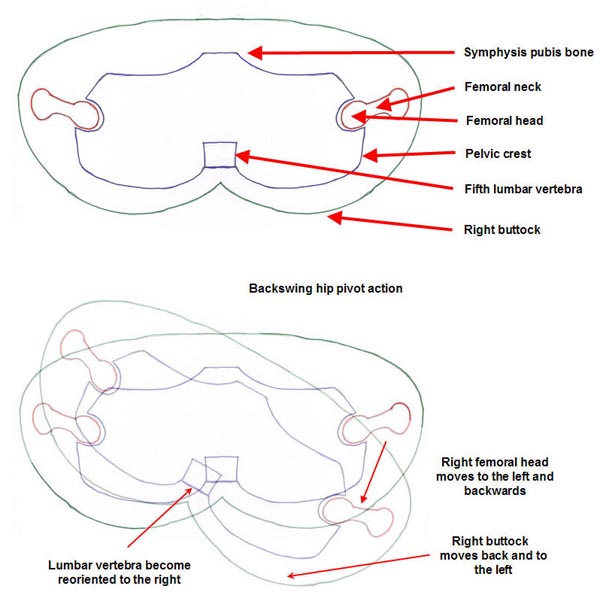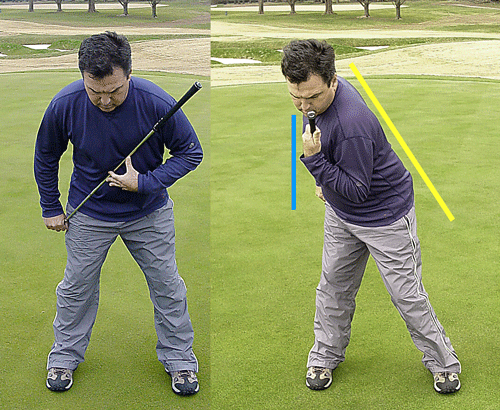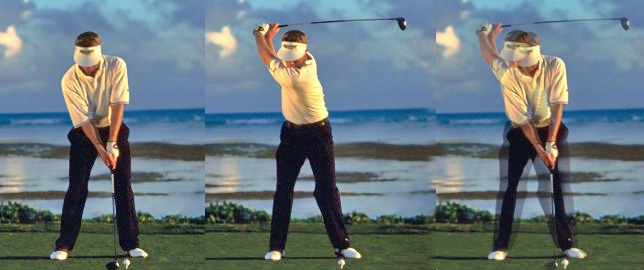Golf MAster Tips, Professional Golfer Backswing Pivot Action - I have described the backswing pivot action in great detail in my The Backswing and Downswing Hip Pivot Movements: Their Critical Role in the Golf Swingreview paper and my Optimal Weight Shift in the Full Golf Swing review paper. I am therefore only going to emphasize certain points in this review paper.
I think that a golfer should pivot-rotate his torso around his rightwards-tilted spine in the backswing and avoid any lateral swaying of the pelvis and/or upper torso to the right.
To achieve that goal, a golfer needs to maintain the flex in his right knee, and ensure that the right knee does not move right-laterally to any degree during the backswing pivot action. It is acceptable for the right knee to straighten slightly - as viewed from a back-to-front perspective.
To achieve that goal, a golfer needs to maintain the flex in his right knee, and ensure that the right knee does not move right-laterally to any degree during the backswing pivot action. It is acceptable for the right knee to straighten slightly - as viewed from a back-to-front perspective.
A key movement of the pelvis in the backswing pivot action is a "feeling" of withdrawing the right hip. The word "withdrawing" merely signifies that the right buttock is pulled back away from the ball-target line, so that the pelvis acquires approximately a 45 degree rotation by the end of the backswing.
During this pelvic rotational movement, the right buttock moves leftwards as well as backwards.

Cross-sectional diagram of the body at the level of the hip joints
Note the effect of the pelvic rotational movement on the orientation of the lumbar vertebra - note that the lumbar vertebra become rightwards-oriented when the right buttocks moves back-and-leftwards. That means that the lumbar spine, and also the lower thoracic spine, becomes rightwards-oriented during the backswing pivot action, and this creates the reverse-K look of a golfer at the end-backswing position.
A golfer can learn the "feeling" of acquiring a reverse-K posture by the end of the backswing by performing the crossing-guard drill.

Brian Manzella demonstrating the crossing-guard drill - from reference number [4]
In this drill, one places a golf club across the front of the torso - from the left shoulder to the right hip. Then, one performs a standard backswing pivot action by withdrawing the right buttock. Note how this action causes the upper torso to acquire a rightwards-slope (yellow line) and note how the clubshaft becomes perpendicular to the ball-target line (blue line). Brian Manzella is "exaggerating" this movement and a golfer should not allow the head to move so much to the right when acquiring a reverse-K posture by the end of the backswing.

Stuart Appleby's head movement during the backswing - images adopted from a swing video
Note that Stuart Appleby has acquired a reverse-K posture by the end of his backswing (image 2) . However, note that he didn't move his head very much during the backswing - see composite image 3.
Note that Stuart Appleby's left leg is straighter than his right leg at address - that is due to the fact that he has shifted his pelvis slightly to the left at address in order to acquire a small amount of rightwards spinal tilt.
Note that Stuart Appleby didn't allow his lower or upper torso to sway to the right during the backswing, and he simply performed a rightwards-centralised backswing pivot action around his rightwards-tilted spine. He is therefore in a perfect position at the end of his backswing to start the downswing pivot action with a hip-shift rotation movement. (Source)
Note that Stuart Appleby didn't allow his lower or upper torso to sway to the right during the backswing, and he simply performed a rightwards-centralised backswing pivot action around his rightwards-tilted spine. He is therefore in a perfect position at the end of his backswing to start the downswing pivot action with a hip-shift rotation movement. (Source)







0 komentar:
Post a Comment